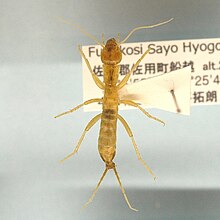Grylloblattidae, the icebugs, or ice crawlers, is a family of extremophile (psychrophile) and wingless insects that live in the cold on top of mountains and the edges of glaciers. They belong, along with Mantophasmatidae (rock crawlers), to the order Notoptera.[2] Grylloblattids are tiny, most being less than 3 cm long, wingless insects with a head resembling that of a cockroach, with long antennae and having elongated cerci arising from the tip of their abdomen. They cannot tolerate warmth (most species will die at 10 °C) and many species have small distribution ranges.
| Grylloblattidae | |
|---|---|
 | |
| Galloisiana nipponensis | |
| Scientific classification | |
| Kingdom: | Animalia |
| Phylum: | Arthropoda |
| Class: | Insecta |
| Order: | Notoptera |
| Suborder: | Grylloblattodea |
| Family: | Grylloblattidae E. M. Walker, 1914 |
| Genera | |
Galloisiana | |
Grylloblattids, ice crawlers or icebugs puzzled the scientists who discovered them in 1914, E.M. Walker and T.B. Kurata; the first species named was Grylloblatta campodeiformis, which means "cricket-cockroach shaped like a Campodea" (a kind of two-pronged bristletail). Most are nocturnal and appear to feed on detritus. They have long antennae (23–45 segments) and long cerci(5–8 segments), but no wings. Their eyes are either missing or reduced and they have no ocelli (simple eyes).[3] Their closest living relatives are the recently discovered Mantophasmatodea.[4] Most species are less than 3 cm long, the largest being Namkungia magnus.[5]
The family has its own suborder, Grylloblattodea (formerly[2] its own order). It contains 5 genera and about 34 extant species.[6][7]
Most species have restricted distributions and small populations and with increased warming their habitats are threatened, making them endangered. In North America some species like Grylloblatta barberi and G. oregonensis are known from single sites.[8]
https://en.wikipedia.org/wiki/Grylloblattidae
Above.
No comments:
Post a Comment